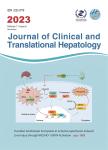Found in Translation
Found in Translation作者机构:Department of Medicine Division of Gastroenterology-Hepatology University of Connecticut Health Center Farmington CT USA
出 版 物:《Journal of Clinical and Translational Hepatology》 (临床与转化肝病杂志(英文版))
年 卷 期:2013年第1卷第1期
页 面:1-1页
学科分类:1004[医学-公共卫生与预防医学(可授医学、理学学位)] 100401[医学-流行病与卫生统计学] 10[医学]
主 题:interferon sustained drugs
摘 要:Since the identification of the hepatitis C virus (HCV) and subsequent cloning of its genome in 1989, only relatively modest progress had been made in the treatment of its chronic infection until recently. Interferon-alfa was approved in 1991 for the treatment of HCV infection, and provided a sustained virological response (SVR) of 9% for genotype 1, and 20–30% for genotypes 2 and 3. With the addition of ribavirin in 1998, the SVR of interferon-ribavirin combination therapy increased to 29% for genotype 1, and 62% for genotypes 2 and 3. The development of long-acting pegy-lated (PEG)-interferons plus ribavirin in 2001–2002 increased SVR incrementally to 41% for genotype 1, and 82% for genotypes 2 and 3. After this advance, the situation remained static for almost 10 years without significant breakthroughs, until the advent of the protease inhibitors telaprevir and boceprevir in 2011. These agents represent the vanguard of a new class of HCV drugs, the direct-acting antiviral agents, and a new era in the treatment of HCV. With the triple therapy regimen of PEG-interferon, ribavirin, and either telaprevir or boceprevir, the SVR for genotype 1 HCV ranges from 70 to 80%. Now, for the first time, persons infected with genotype 1 HCV can expect a higher than 50%chance of achieving an SVR to antiviral therapy.



